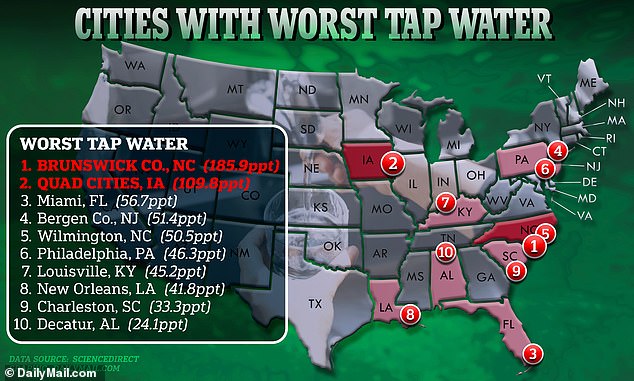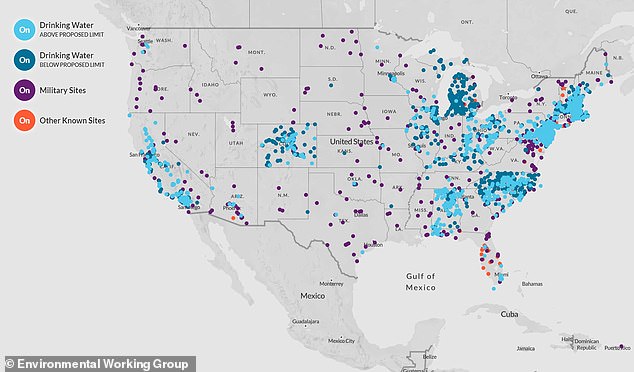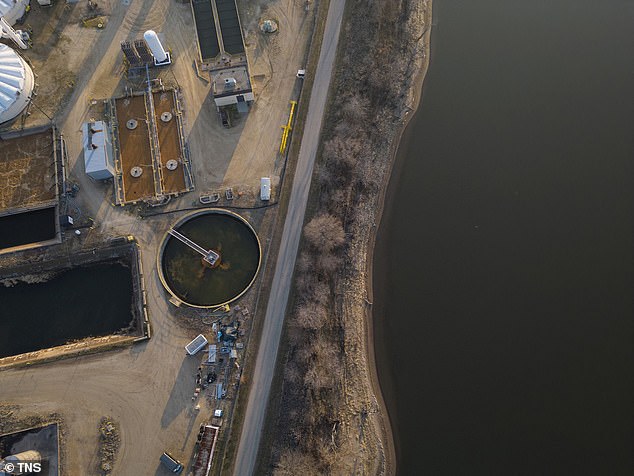
A new study has revealed that North Carolina and Iowa have the areas with the most toxic tap water in the nation, sparking concerns and questions about the reasons.
While nearly half of the tap water in the U.S. was found to be laced with hormone-warping ‘forever chemicals,’ Brunswick County, N.C. and Quad Cities, Iowa, had significantly higher levels of PFAs in their drinking supply.
In the most comprehensive study of its kind, researchers from the US Geological Survey tested water sources at more than 700 locations across the country for per- and polyfluoroalkyl substances (PFAS).
They found that the next city with the worst levels of PFAs in its tap water, Miami, Florida, was way behind the two top spots, at 56.7ppt. Brunswick County registered levels at 185.9ppt and Quad Cities at 109.8ppt.
In recent years there have been a growing number of federal drinking-water guidelines, but there are no current enforceable national drinking water standards. But the Environmental Protection Agency (EPA) limits PFAS to 0.004 parts per trillion (ppt) for drinking water, a small amount due to their links to cancer, infertility, obesity, and autism.

Brunswick County, N.C. and Quad Cities, Iowa, have significantly higher levels of PFAs in their drinking supply




The Environmental Working Group, an activist organization centered on environmental pollutants, mapped out the communities and military sites confirmed to have PFAS contamination
North Carolina at large has been known to have significant issues with PFAS pollution as the state has a large number of military bases, airports and industrial sites. PFAS are commonly found in firefighting foam and gear, which has led to contamination of military bases and airports.
The problem is particularly grave along the Cape Fear River partly because of the DuPont plant in Fayetteville and its spin-off, Chemours.
According to the National Resources Defense Council (NRDC), the DuPont chemical company dumped PFAs for over four decades into the river, which supplies drinking water for around 350,000 North Carolinians.
Many of the area’s residents have claimed over the years that they got cancer from the contamination. Back in 2019, scientists recommended expanding an investigation of suspected thyroid cancer clusters in the area, as reported by NC Newsline.
In 2017, the Cape Fear Public Utility Authority filed a lawsuit against the company over their dumping of toxic materials in the river, and in 2020 the state’s Attorney General filed another.
DailyMail.com has reached out to DuPont and Chemours for comment on this story.
In Iowa’s Quad Cities, the 3M plant in nearby Cordova, Illinois, has been partly blamed for the high levels of toxins in the tap water. The company is one of the country’s largest producers of PFAS and has been accused of dumping chemicals in the Mississippi River, as reported by the Quad-City Times.
The manufacturing plant makes adhesives for Post-it notes, golf clubs and LCD displays.
DailyMail.com has contacted 3M for comment on this story.
The new study has raised concerns around the nation, with New York representative Pat Ryan saying the situation is ‘unacceptable.’
‘Everyone should have the freedom to turn on their tap without the fear they are drinking poisoned water,’ he tweeted. ‘We need to take immediate action to remove these toxins from our water.’
Experts said the findings were ‘frightening’ given the scale of the problem and the link between the toxins and serious health conditions like cancer, infertility, birth defects and hormone issues.
These microscopic, man-made chemicals can take thousands of years to break down in the environment or in the human body, hence the name ‘forever chemicals’.






In Iowa’s Quad Cities, the 3M plant in nearby Cordova, Illinois, has been partly blamed for the high levels of toxins in the tap water over their dumping of chemicals in the Mississippi river
The report found that 45 percent of drinking water sources contained at least one PFAS – with highest concentrations in the Great Plains, the Great Lakes, the Eastern Seaboard and Central/Southern California.
Researchers set out to determine levels of PFAS in water sources across 716 unique sites nationwide, including both urban and rural areas.
Over the course of five years spent collecting samples to detect PFAS levels, the team concluded that taps in densely populated urban centers were generally more laden with the forever chemicals than taps in rural parts of the country.
This is due to the fact everyday home products from frying pans to food packaging contain PFAS that leach into the water supply, and urban areas tend to be situated closer to manufacturing plants.
The main purpose of PFAS compounds is to repel water and oil, which is what makes non-stick cookware so much easier to clean and why certain jackets and tents can withstand rain.
PFAS can seep into the water supply by simply washing the dishes. The compounds can also seep into our food if the packaging is made to be grease-resistant – think fast food cheeseburgers – or if the non-stick coating on pots and pans begins to deteriorate.
PFAS are also common in pesticides used to feed crops, which produces chemical-rich runoff that can enter the drinking water supply.
Source: | This article originally belongs to Dailymail.co.uk